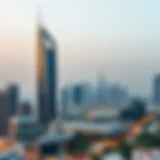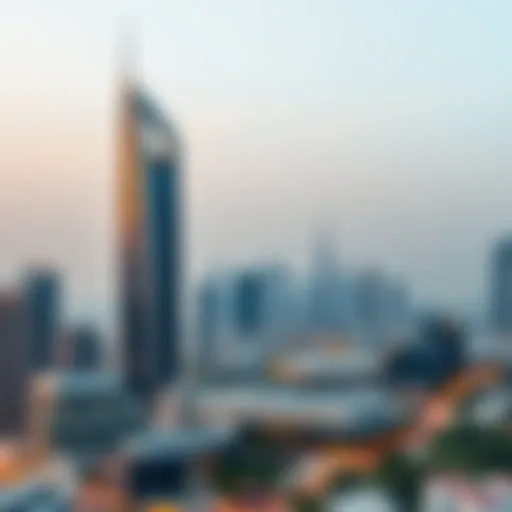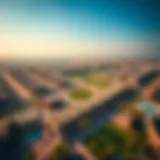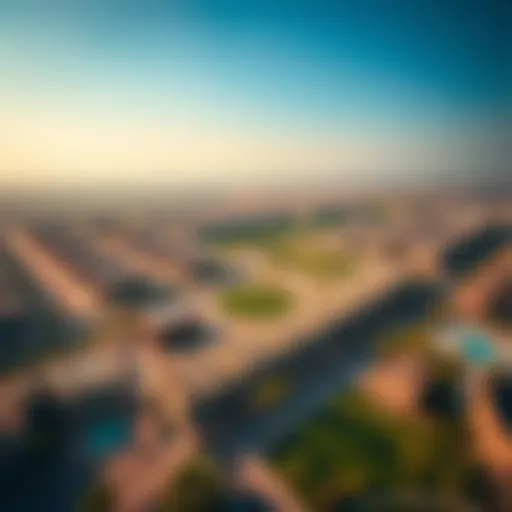The Historical Market of Dubai: A Cultural Journey
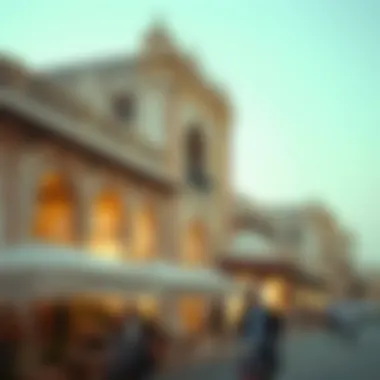

Intro
Dubai's historical market, known as سوق القديم, is not just an open-air trading hub; it symbolizes the soul of the city, a melting pot of cultures, traditions, and commerce. While skyscrapers and modernity dominate Dubai's skyline today, many might overlook the significant tales echoing from its vibrant maze of stalls and shops. This article takes you on a deep dive where we peel back layers of history and examine how this market has evolved through the ages, solidifying its role as a cornerstone of Dubai's heritage.
As you step into سوق القديم, you're not merely a spectator; you engage with a living museum. Each vendor has a story to tell, connected intrinsically to the city's development and the ebb and flow of trade in the region. We'll explore the market's architecture, the traditional crafts that thrive within its bustling alleys, and how these elements have adapted to meet modern demands.
But this exploration is not just about the past. The market offers insights into current trends that affect both visitors and investors alike. Understanding these dynamics is key for anyone interested in the local economy or looking to delve into real estate opportunities here.
Join us as we navigate this rich tapestry, uncovering the historical and contemporary significance of سوق القديم, and what it means for residents, traders, and those keen on investing in Dubai's multifaceted marketplace.
The Essence of سوق القديم
The essence of سوق القديم, or the Old Market, in Dubai cannot be overstated. It serves as a living testament to the city’s vibrant history and cultural evolution. The market is not only a place for commerce but also a gathering space that reflects the soul of the community. Here, tradition dances with modernity, creating a unique blend that attracts residents and tourists alike.
One of the primary elements that define سوق القديم is its enduring role in facilitating trade and commerce. Stretching back to a time when Dubai was but a small fishing village, the market drew merchants from across the Arabian Peninsula and beyond. As trade routes flourished, this market became a hub where goods—from spices to textiles—were exchanged. This rich history of trade has paved the way for the market's contemporary relevance, underscoring its significance as an economic engine. A deeper understanding of this marketplace unveils the layers of interactions that have shaped both Dubai and its people.
Defining the Old Market
Sوق القديم is characterized by its narrow alleys, bustling stalls, and the scent of incense filling the air. This market is more than just a commercial venue; it’s a cultural landmark that stands as a bridge to the past. When one strolls through its winding paths, they encounter a myriad of shops selling everything from traditional garments to intricate handicrafts. Each stall serves as a reflection of the artisan's dedication, making every item unique in its craftsmanship.
The market has undergone changes over the years, adapting to modern tastes without losing its charm. Despite this evolution, it retains its identity as a social and economic hub, where generations have gathered to barter, buy, and build relationships.
Cultural and Historical Layers
The layers of culture enveloping سوق القديم are richly woven. Historically, it was a venue for not only trade but also storytelling, where merchants would share tales of their travels and traditions. As you navigate through the market, there's an undeniable palpable energy created by conversations filled with laughter and deals being struck. This interaction has fostered a sense of community which is crucial to the historic fabric of Dubai.
In recent times, the significance of cultural events within the market has become more pronounced. Festivals and fairs are often held here, where local flavors and crafts are celebrated, allowing for dynamic cultural exchanges. Such events draw both locals and tourists, bridging gaps and sustaining cultural heritage.
"A walk through سوق القديم is like flipping through the pages of a history book; every vendor holds a story and every item has a history."
Moreover, the historical architecture of the market showcases traditional design principles, reinforcing its cultural relevance. The wind towers, known locally as barjeel, are a testament to ancient cooling methods that exemplify local ingenuity in adapting to the desert climate.
As we peel back the layers of the old market, we find a rich tapestry of cultural and historical narratives that continue to shape Dubai’s identity. Understanding these elements is crucial for anyone wishing to grasp the essence of this remarkable marketplace.
Architectural Elements
The architectural elements of سوق القديم hold a distinct significance in comprehending the essence of this historical market. Each structure not only reflects the cultural identity of Dubai's past but also showcases the ingenuity of traditional craftsmanship. As these design choices sift through time, they tell stories of adaptation and resilience, making it crucial to understand how they shaped the market's atmosphere.
Traditional Design Features
When one steps into سوق القديم, the eye is immediately drawn to its unique architectural features. The wind towers, also known as barjeel, stand tall against the desert sky. These structures act as natural air conditioning, guiding cooler breezes down into the market space. The traditional use of courtyards provides a sense of openness, allowing light to filter gently into the shops.
Another striking feature is the use of Mashrabiya screens. These intricately carved wooden lattices not only serve as decorative elements but also provide privacy while allowing airflow. The strategic placement of arched doorways and vibrant tile work further accentuates the overall aesthetic, imbuing a sense of history with every step taken.
The incorporation of natural materials—such as stone, plaster, and wood—adds to the market's authenticity. This is where form meets function; the materials used are well-suited for the regional climate while paying homage to the local culture. The simplicity yet elegance of these features create a unique harmony, inviting visitors to explore more.
Materials Used in Construction
Turning the spotlight on construction materials, it’s clear they play a vital role in maintaining the integrity of سوق القديم. Coral stone, widely used in early architecture, serves as a testament to Dubai's maritime history. These stones were sourced from the nearby Persian Gulf and perfectly align with the environmental landscape. Together with plaster, they create a solid foundation that has withstood the test of time.
- Date Palm Wood: This locally sourced material was extensively used for beams and ceiling supports, providing strength as well as a touch of local craftsmanship.
- Mud-brick: Though less common now, mud-bricks were historically significant for their insulating properties, keeping interiors cooler during the sweltering heat.
- Limestone: Found in abundance, limestone is another material that forms the backbone of various structures within the market.
The careful selection of these materials not only highlights a commitment to sustainability but also promotes a sense of connection to the land. As stakeholders in real estate, understanding these components can provide valuable insight into the potential for preservation and renovation within the market.
In essence, the architectural elements of سوق القديم are not merely visual delight; they narrate a tale of cultural significance, intertwined with stories of resilience.
The evolving nature of this market necessitates a keen eye on its architectural features, for they remain a living testament to Dubai's rich heritage.
Economics of the Market
The economics of سوق القديم represent a cornerstone of Dubai's historical commerce and community interaction. This section elucidates the significance of the marketplace not only as a center of trade but as a dynamic engine driving local economies. It showcases how this age-old market contributes to the socio-economic fabric of the area, nurturing relationships and enhancing the quality of life for both residents and visitors. Understanding the economics of the market helps investors, home buyers, and real estate professionals grasp its influence and potential.
Types of Goods and Services Offered
Sوق القديم is a treasure trove of diverse offerings, showcasing a blend of traditional and contemporary products. Visitors can find:
- Textiles: From exquisite silk and cotton fabrics to vibrant scarves, the market's textile vendors offer a plethora of choices.
- Spices: An aromatic delight, the spice stalls brim with everything from saffron to cardamom, attracting not just locals but also chefs and culinary enthusiasts.
- Handicrafts: Local artisans sell beautifully crafted items like pottery, wood carvings, and metal works, representing Dubai's rich cultural heritage.
- Culinary Experience: Numerous eateries serve local dishes like Shawarma and Falafel, providing flavorsome experiences that meld traditional recipes with modern tastes.
In addition to tangible goods, various services are offered—ranging from personalized shopping guidance to cultural experiences that help visitors engage with the market's history and community customs. The blend of goods and services creates a vibrant ecosystem, attracting shoppers from all around and cementing the market’s significance in Dubai's commercial landscape.
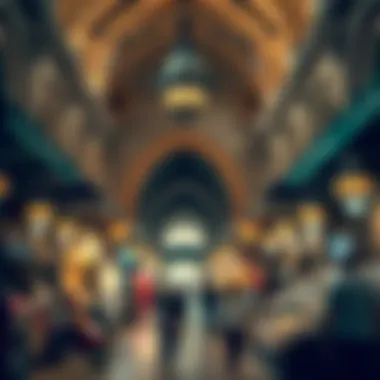

Impact on Local Economy
The contributions of سوق القديم to the local economy cannot be overstated. It serves as a vital source of employment, supporting approximately thousands of local vendors and artisans. The circulation of money within the market often translates to:
- Increased sales and revenue for local businesses.
- Growth in job opportunities, fostering a stronger community.
- A rise in tourism, driving further investment in the area.
Furthermore, the market plays a key role in training the younger generation in traditional crafts, ensuring the preservation of skills and techniques that have been passed through generations.
"The market serves not just as a place to shop, but as a living museum of Dubai's heritage, where the past meets the present and drives our future.”
Engagement in this historical hub is a pathway for local residents and expatriates alike, often leading to an enhancement of property values in nearby residential areas, ultimately benefiting investors and property managers seeking promising investments. The symbiotic relationship between the market and local economy speaks volumes about the enduring significance of this cultural landmark.
Visitor Experiences
When it comes to exploring سوق القديم, the experience a visitor encounters is as rich and layered as the market itself. This section dives into the essence of the visitor experience, emphasizing how it shapes the understanding and appreciation of this historical marketplace. The market acts like a living museum, a blend of culture, tradition, and modernity right before one’s eyes. The excitement of navigating through its narrow alleyways, each turn revealing a treasure or a hidden gem, is unparalleled. Every visit offers more than just shopping; it becomes a voyage into the heart of Dubai’s history and culture.
Navigating the Market
Navigating through سوق القديم can feel like stepping into a different era. The winding lanes are lined with shops, each boasting an array of items that reflect the rich heritage of the region. Whether you’re hunting for exquisite textiles, intricate handicrafts, or aromatic spices, this market caters to diverse tastes. However, navigating is more than just an exercise in shopping; it's about understanding the rhythm of the marketplace.
For new visitors, the key points to keep in mind are:
- Familiarize with the Layout: The market is split into various sections, each specializing in particular goods, like textiles, spices, or souvenirs. Taking a few moments to get oriented can save time and enhance the experience.
- Engage with the Vendors: The vendors are not just sellers; they are storytellers. Engaging with them leads to fascinating narratives about the products and the market itself, providing context that enriches the shopping experience.
- Be Prepared to Bargain: Negotiating prices is expected. This traditional practice is not merely about haggling; it’s part of the cultural dance that a visitor participates in.
Culinary Delights and Local Cuisine
The culinary offerings at سوق القديم present another enriching layer to the visitor experience. Beyond merely tasting food, it becomes an exploration of local culture and tradition. Street food vendors serve dishes that tell stories of the region’s history and culinary evolution. Notable treats that shouldn’t be missed include:
- Shawarma: Thinly sliced meat, marinated and roasted, served in pita bread with fresh vegetables and sauces. This is a must-try that captures the essence of local flavors.
- Knafeh: A sweet, cheese-filled pastry often served warm, drizzled with syrup, revealing the sweet side of Emirati cuisine.
- Harees: A savory dish made from wheat and meat, commonly enjoyed during festivals and celebrations, offering a taste of tradition.
In addition to individual food stalls, some vendors offer small seating areas, providing a chance to indulge in these flavors while soaking in the market’s bustling atmosphere. It's not just about the eating; it's about sharing a moment in time and culture.
"Food is the bridge to understanding a culture, and in سوق القديم, every bite tells a story."
Through the diverse culinary experiences, visitors can trace the roots of the community's preferences and practices while enjoying a feast for the senses. For many, these flavors become lasting memories, the tastes that will linger long after they've left Dubai.
In a nutshell, the visitor experience in سوق القديم transcends mere observation; it’s an immersive journey that bonds the past with the present. Understanding the market's layout, connecting with its vendors, and indulging in its culinary offerings allow travelers to fully appreciate the richness of Dubai's heritage.
Trade Practices in the Old Market
The trade practices in سوق القديم are not just transactions; they represent a rich tapestry of culture, tradition, and history. This section uncovers the vital components of how trade has evolved over decades within this iconic marketplace and the implications it has both locally and beyond.
Traditional Trading Methods
In the heart of دبي, the old market is a cavern of history where time seems to stand still, and traditional trading methods carry echoes of a bygone era. Vendors often display their wares in open-fronted shops, allowing goods to spill out into the narrow alleyways. These methods are characterized by several key elements:
- Bargaining and Negotiation: One of the most distinct features of traditional trading here is the art of bargaining. Haggling isn’t just permitted; it’s expected. Both buyer and seller engage in a lively back-and-forth, often resulting in a price that feels mutually agreeable. This not only makes for a more personable shopping experience but also helps foster relationships based on trust.
- Personal Connection: Many tradesmen in the market have family ties to the commerce they pursue, having inherited both goods and techniques from previous generations. This familial connection adds layers of authenticity to the experience of buying spices, textiles, or gold jewelry. Buyers leave with more than just goods; they gain a piece of history.
- Specialized Crafts: Various sections of the market are often dedicated to specific types of goods— from carpets to potions—allowing artisans to showcase their unique crafts. This specialization not only influences pricing but also encourages a knowledgeable dialogue among buyers familiar with the craft.
Such methods have resistence against modern practices; the personal touch and rich history give them an edge. Although many buyers may prefer the convenience of corporate stores, the unique experience of negotiating for a handcrafted item often draws them back to the old ways.
Shifts Towards Modern Practices
While фтннш trading methods remain prevalent, the winds of change have swept through سوق القديم, mainly influenced by technology and globalization. Here’s how the marketplace is adapting:
- Digital Transactions: As much as tradition reigns, the allure of technology is hard to ignore. The rise of digital payments, such as mobile wallet apps, is visible even in the old market. Vendors take advantage of new payment methods to cater to tech-savvy tourists and locals alike, allowing faster and more secure transactions.
- Online Presence: More and more shops are establishing an online presence, showcasing products via social media platforms. Vendors are utilizing platforms like Instagram and Facebook to widen their audience, connecting with potential buyers who may never step foot in the historical marketplace.
- Influencer Partnerships: Collaborations with local influencers have emerged as a novel strategy to attract younger audiences. Video walkthroughs and live trading sessions help bridge the gap between traditional crafts and contemporary shopping behavior.
"Embracing technology while honoring tradition allows سوق القديم to thrive in modern economy."
These shifts facilitate a hybrid market model that continues to engage both traditional shoppers and a new, younger demographic. Balancing this old and new presents both opportunities and challenges, making the future of trade practices in سوق القديم both exciting and uncertain.
Cultural Events and Festivals
The cultural vibrancy of سوق القديم is brought to life through its various events and festivals, playing an central role in maintaining the market's connection to tradition and community values. These gatherings not only celebrate the rich heritage of Dubai but also foster economic activity, engaging both locals and tourists. The importance of cultural events and festivals in this market lies in their ability to bridge the past with the present, reminding the world of the city’s roots while showcasing its ongoing evolution in the modern landscape.
Significance of Cultural Events
Cultural events woven through the fabric of سوق القديم reinforce a sense of belonging and pride among the residents. These occasions serve multiple purposes:
- Cultural Preservation: They keep alive the stories, music, and crafts that have defined the heritage of the area for generations. Traditional dances, music performances, and art exhibitions allow locals to connect with their ancestry while educating visitors.
- Economic Booster: Festivals attract a diverse crowd, leading to increased foot traffic for market vendors and service providers. This boosts sales and helps sustain local businesses, contributing beneficially to the economic environment.
- Community Engagement: Events foster unity among residents and encourage participation from different communities, promoting multicultural interactions and solidarity. By hosting workshops and interactive activities, the market becomes a hub for learning and sharing.
- Tourism Appeal: Events create unique experiences for tourists, enhancing their connection to Dubai. Tourists look for authentic experiences, and these cultural celebrations provide them a glimpse into local life, bridging cultural gaps in a lively setting.
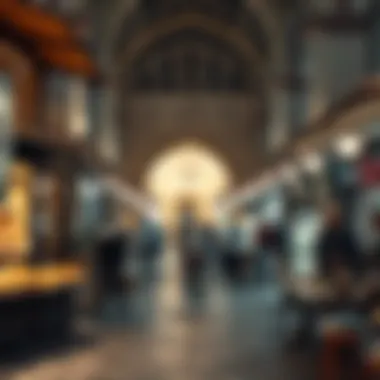

"Through the vibrant tapestry of cultural events, the spirit of سوق القديم flourishes, encapsulating the history and aspirations of its people."
Festivals Celebrated in the Market
Sوق القديم boasts numerous festivals throughout the year, reflecting its cultural diversity and historical significance. Some notable celebrations include:
- Dubai Shopping Festival: An annual month-long event that transforms the old market into a bustling marketplace featuring discounts, live entertainment, and cultural displays. It celebrates both traditional crafts and modern shopping, attracting shoppers worldwide.
- Eid Festivals: Marking the end of Ramadan, the Eid celebrations at سوق القديم encompass traditional prayers, feasting, and various local art showcases. The market is adorned with festive decorations, and local food stalls provide traditional delicacies that create a warm, joyous atmosphere.
- National Day Celebrations: On December 2nd, the market comes alive with celebrations featuring parades, music, and cultural performances. This event brings together families, and local artisans display their crafts, emphasizing national pride and hospitality.
- Heritage Festivals: These gatherings occur several times a year, highlighting Emirati culture through arts, crafts, and storytelling. They often feature local folklore, singing, and handicraft competitions, providing opportunities for emerging artists to showcase their talents.
- International Book Fair: Highlighting the importance of literature and education, this fair brings together writers, poets, and readers from across the world. While not exclusively held in سوق القديم, it often hosts events within the market, promoting reading and cultural exchange.
Through these festivals, سوق القديم stands not just as a marketplace but as a cultural landmark, deeply rooted in the heart of Dubai. As it embraces both tradition and innovation, the market continues to evolve while preserving its rich legacy.
Legacy and Preservation Efforts
The legacy of سوق القديم serves as a testament to Dubai's rich cultural mosaic. As times change, ensuring the preservation of such historical markets is imperative, not just for the local inhabitants, but also for the global community that seeks to understand and appreciate diverse traditions. Within this section, we'll explore critical initiatives aimed at protecting the essence of this iconic marketplace and the hurdles that may inhibit these efforts.
Local and Government Initiatives
Several local and governmental bodies have taken proactive steps to ensure the continuity of traditional markets like سوق القديم. These initiatives include a myriad of funding programs, educational ventures, and community involvement projects. For instance, Dubai Culture and Arts Authority has led the charge to recognize the market’s cultural significance by investing in restoration projects that maintain its authenticity. Government-led initiatives often focus on:
- Conservation Projects: Comprehensive plans are developed to restore old structures and ensure that renovations respect historical integrity.
- Awareness Campaigns: Programs designed to educate the public about the market’s significance and encourage them to participate in its preservation.
- Community Engagement: Opportunities for residents and local businesses to contribute to the market’s sustainability, often giving them a vested interest in its success.
- Cultural Exchange Programs: These facilitate interactions between local traders and international visitors, enriching the market's offerings and maintaining its relevance in a global context.
Through these efforts, the vibrancy of سوق القديم is not merely a memory; it thrives as a living entity with a pulse grounded in history.
Challenges in Preservation
Despite the well-intentioned efforts to preserve سوق القديم, various challenges present themselves, threatening the integrity and future of the market. Urbanization remains a significant concern, as new developments encroach upon traditional spaces. Some pressing challenges include:
- Rapid Urbanization: As Dubai continues to expand, newer commercial areas overshadow these traditional markets, risking their viability.
- Financial Limitations: While there is a will to preserve, lacking robust financial support can lead to incomplete or superficial restoration efforts.
- Cultural Dilution: With the influx of modern retail influences, there is a danger of market identity becoming blurred, making it harder to retain distinct cultural characteristics.
- Tourism Pressures: An increasing number of tourists can sometimes lead to commercial practices that prioritize profit over maintaining the authenticity of the market experience.
As these obstacles arise, it becomes crucial not only to tackle them head-on but also to formulate innovative strategies that ensure the safeguard of Dubai's marketplace heritage.
The future of سوق القديم lies in the hands of those who cherish its past and recognize its role in crafting a vibrant cultural legacy.
Modern Adaptations of the Market
In the heart of دبي, the old market, or سوق القديم, stands as a testament to the enduring traditions and evolving landscape of commerce. Its modern adaptations are not just a gimmick; they reflect a keen understanding of both historical significance and contemporary consumer needs. This blend of old and new is crucial in ensuring that the market continues to thrive in a rapidly changing environment. Notably, the ways in which the market integrates with contemporary shopping and the technology employed are significant facets of this transformation.
Integration with Contemporary Shopping
In recent years, سوق القديم has embraced changes that cater to modern shoppers while retaining its authentic charm. The market's layout has been adapted to create a more navigable environment, enhancing both foot traffic and sales potential. Local merchants now showcase their products in a manner that aligns with shoppers' expectations today:
- Accessibility: Enhanced pathways allow for easier movement, accommodating larger crowds, especially during peak tourism seasons.
- Multifunctional Spaces: Traditional stalls are now juxtaposed with pop-up shops and boutique experiences that offer artisanal goods alongside mass-produced items, attracting a diverse clientele.
- Visual Merchandising: Vendors have started using contemporary display techniques which make products more appealing to passersby, combining tradition and trendy aesthetics.
Visitors can now find a range of goods, from handmade crafts to luxury items, making سوق القديم a vibrant destination for both the local community and foreigners alike. This fusion creates a unique shopping experience where one can feel the pulse of history while enjoying modern conveniences.
Impact of Technology on the Market
Technology plays an increasingly pivotal role in the evolution of سوق القديم. With the digital age upon us, merchants are adopting innovative practices that enhance customer engagement and streamline operations. Here are a few notable impacts of technology on the market:
- E-commerce Integration: Many vendors have set up online platforms, allowing customers to browse and purchase products from the comfort of their homes. This especially caters to expatriates who want to buy local goods but cannot always visit the market in person.
- Mobile Payments: Cash is not always king anymore. With the introduction of mobile payment systems, transactions are quicker and safer, appealing to tech-savvy shoppers who prefer contactless payments.
- Social Media Marketing: Vendors actively showcase their products on social media platforms, drawing in a global audience. These marketing strategies help boost visibility and attract new customers who might not have known about the market.
"Technology is not just about gadgets; it’s about enhancing human experiences. In سوق القديم, it's a bridge connecting the past with the future."
By amalgamating these modern adaptations, سوق القديم has not only preserved its essence but has also positioned itself as a forward-looking marketplace. Each improvement reflects a response to changing tastes and behaviors, ensuring its relevance for generations to come.
Impact of Tourism
The old market of Dubai, or سوق القديم, stands as a vibrant epicenter of cultural exchange and economic activities, drawing both locals and tourists alike. The significance of tourism in this area cannot be understated. By understanding how tourists contribute to the market’s vitality, we can appreciate the intricate tapestry of history, commerce, and community that defines this marketplace.
Role of Tourists in Revitalizing the Market
Tourism plays a crucial role in revitalizing the market. When tourists step into سوق القديم, they see more than just a shopping destination; they see a living mosaic of tradition and modernity. Their footsteps breathe new life into the market's bustling alleys, where local vendors showcase their wares, from intricately woven textiles to spices that paint a fragrant picture of the region’s rich culinary heritage.
Many artisans and small businesses depend heavily on tourist traffic. Increased footfall means that business can thrive, enabling these sellers to maintain their crafts and traditions, which may otherwise be sidelined in a rapidly modernizing world. Visitors often express genuine curiosity about artisanal practices, rekindling the flame of interest in these age-old techniques.
As tourists explore the market’s nooks and crannies, they engage with vendors, sparking conversations rich with cultural exchange. This two-way interaction not merely enhances the experiences of tourists but also instills a sense of pride and purpose among local sellers. Through these connections, the market fosters a shared appreciation of heritage that transcends boundaries.
Economic Benefits from Tourism
The economic benefits stemming from tourism in سوق القديم are substantial and multifaceted. Significant revenues are generated through both direct and indirect channels. For local vendors, processing payments in cash and accepting various forms of currency allows for travelers from around the world to indulge in the local economy easily. This aspect alone ensures that the financial flow remains robust within the community.
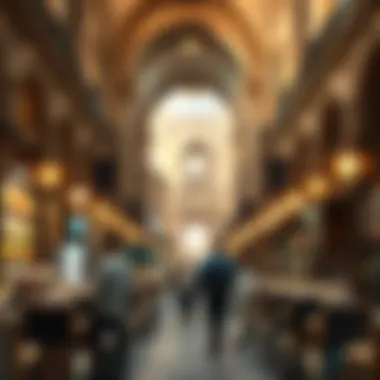

Moreover, tourism contributes to job creation. Beyond the sellers, it supports a wide array of services—guides have emerged who narrate stories of the market's history, while nearby restaurants thrive on the influx of customers seeking authentic dining experiences. Parking attendants, arts and crafts workshops, and cultural entertainment further enrich the market atmosphere and economy as tourists seek out vibrant experiences while visiting.
Consequently, it’s not just about money in transactions; it’s about the multiplier effect. As tourists spend in the market, they inadvertently contribute to a broader economic system encompassing hotels, transportation, and food supplies. Such interconnections enhance the resilience of Dubai's economic landscape, making سوق القديم not merely a shopping locale but a linchpin of local prosperity.
"Tourism is a vital lifeline, reinvigorating local traditions while ensuring the market serves not only as a commercial hub but as a cultural sanctuary."
Ultimately, the impact of tourism on سوق القديم is evident in its bustling environment, rich cultural exchanges, and economic robustness. Tourists’ appreciation for the market’s unique offerings not only revitalizes the present but also helps preserve and celebrate its heritage for generations to come.
Personal Perspectives
The Personal Perspectives section plays a crucial role in painting a vivid picture of سوق القديم. It emphasizes the market's dynamic character through the eyes of those who interact with it daily. Investors, home buyers, real estate agents, property managers, and renters can gain a profound understanding of the market's value and appeal. Listening to local voices allows potential stakeholders to appreciate the market's heartbeat, the intertwining of past and present, and the individual stories that shape its identity.
Interviews with Local Vendors
Engaging directly with local vendors reveals a rich tapestry of experiences and insights regarding سوق القديم. Each vendor carries a unique story, often handed down through generations. For instance, Ahmed, a spice merchant, talks about his grandfather who first set up shop in the 1960s. He shares how the market has changed from a simple trading post to a vibrant commercial hub. Vendors like Ahmed provide not just goods but also a connection to the past, religion, and traditions.
In interviews, they express concerns regarding modern advancements, such as the surge of e-commerce, which has altered consumer behaviors. What stands out is their unyielding passion for preserving the authentic atmosphere amidst changing times. As Fatima, a textile seller, puts it, "This market is not just commerce; it holds our culture. I wish more people could see that."
These conversations deepen investors' understanding of local market conditions and enable property managers to grasp the historical context that influences current trends. Moreover, it’s also crucial for tourists who seek authentic experiences.
Visitor Testimonials
Visitors to سوق القديم often recount transformative experiences, recapturing the essence of Dubai that modern structures sometimes overshadow. Testimonials frequently highlight the rich sensory experience; the sounds of vendors calling out prices, the vibrant colors of textiles, and the unmistakable aroma of spices create an enchanting atmosphere.
"Walking through the narrow lanes felt like stepping back in time. Each stall tells a story, and every corner has a new surprise. I found spices I'd never seen before, and the local people were so warm!" – Sarah, traveler.
Such personal accounts not only enrich the narrative of the market but serve as invaluable insights for potential investors and buyers assessing the market’s attractiveness. These tales cultivate a sense of community and connection that cannot be found in a standard tourist guide.
Overall, both vendor interviews and visitor testimonials highlight the vibrancy of سوق القديم, showcasing its value not just as a shopping location but as a living heritage site. This impact on both social relationships and the local economy is often understated but vital.
In this digital age, where everything has gone online, the testament of a market that thrives on human interaction and cultural exchange acts as a beacon. It shows how the essence of Dubai's trading history remains relevant, emphasizing the need for preservation and respect for traditions even as we march forward into the future.
Comparative Analysis with Other Markets
Understanding the dynamics of سوق القديم in contrast to other regional markets provides a multifaceted perspective on its significance within Dubai's commercial landscape. An analysis of this type allows for an exploration of not just the operational similarities and differences, but also the socio-economic implications of these contrasts. When positioned alongside other markets, it becomes evident how سوق القديم serves as a unique testament to Dubai's rich heritage, while also adapting to modern flows of commerce and tourism.
Similarities with Regional Markets
Many markets throughout the Middle East share common threads, particularly in their merchandising strategies and cultural significance. For example:
- Vibrant Bargaining: Much like the souks in Marrakech or the bazaars in Istanbul, سوق القديم showcases the age-old practice of bargaining. This interactive financial exchange brings vendors and customers closer, encouraging negotiation and personal connection.
- Cultural Highlights: Markets like the Muttrah Souq in Oman and the Khan el-Khalili in Egypt not only sell goods but also serve as cultural hubs where traditional music and food intertwine with the shopping experience, mirroring the social life found in سوق القديم.
- Diversity of Goods: Similar to the Grand Bazaar in Istanbul, which offers everything from textiles to spices, سوق القديم boasts a variety of products, from handmade artifacts to exquisite perfumes, each reflecting the cultural identity of Dubai.
However, while these shared features underscore connective tissue among regional markets, they also highlight the distinct flavor of سوق القديم, which is steeped in the local heritage of Dubai.
Unique Aspects of سوق القديم
What truly sets سوق القديم apart in the marketplace is not just what it offers, but how it creates an experience tailored uniquely to its patrons.
- Cultural Immersion: While many markets offer a glimpse into local life, سوق القديم goes a step further. Visitors often comment on the immersion they feel when surrounded by traditional art forms and local crafts that directly reflect the history of the area. This connection to cultural heritage fosters a richer customer experience than what many modern shopping centers can provide.
- Community Bonding: The close-knit relationships between vendors and regular customers cultivate a sense of belonging for locals. It is not unusual to see friends exchanging pleasantries over a cup of traditional Arabic coffee at the open-air cafes located within the market. This sentiment is less prevalent in more commercially-driven spaces.
- Sustainability Practices: Many local vendors at سوق القديم prioritize sustainable sourcing of their materials, favoring artisanship over mass production. This commitment is less commonly observed in other markets, where the emphasis might lean towards quick profit margins rather than long-term sustainability.
"Sوق القديم serves not just as a marketplace, but as a cultural landmark where tradition intertwines with the modern, creating a unique sense of community that is hard to find elsewhere."
Conclusively, comparing سوق القديم with other markets helps to clarify its position within the broader economic and cultural framework of the region. The intersections of tradition, community, and modernity at سوق القديم are not only essential for its own identity but also contribute significantly to Dubai’s allure as a city that bridges the past with the present.
Future Outlook
The future outlook for سوق القديم holds substantial significance within the broader context of Dubai's ever-evolving urban landscape. As economic patterns shift and technological advancements persist, the old market stands at a junction where tradition meets innovation. This synergy of old and new is crucial for preserving the market's rich history while also ensuring that it thrives in the competitive market environment.
Highlighting Key Elements
Several factors contribute to the future trajectory of سوق القديم, including:
- Adaptation to New Demands: As consumer preferences evolve, there's a pressing need for the market to adapt. Buyers today seek more than just traditional goods; they are drawn to experiential shopping that offers a cultural connection coupled with modern conveniences.
- Sustainability Practices: Increasing awareness of environmental issues is prompting markets worldwide to adopt sustainable practices. Integrating eco-friendly initiatives could be a game changer for سوق القديم, attracting a demographic that values sustainability.
- Digital Presence: The role of online platforms is undeniable. Expanding the market’s digital footprint will allow local vendors to access a broader customer base, enhancing their visibility without losing the market’s authentic charm.
"Understanding the market’s engagement with technology and sustainability will be key in navigating its future."
Predicted Trends in the Marketplace
The coming years are likely to see several notable trends emerging within وم ج الله. One major trend is the rise of hybrid market experiences where traditional shopping meets digital conveniences. As tourists and locals become accustomed to online shopping, the expectation for brick-and-mortar experiences to provide digital interactions will grow.
Among the most impactful outcomes of this shift might include:
- Smart Shopping Amenities: Implementation of smart technology, such as interactive kiosks or mobile apps, can enhance consumer engagement and streamline processes.
- Curated Experiences: Consumers are increasingly favoring personalized experiences. Markets like سوق القديم may benefit from tailoring their offerings to reflect unique cultural experiences, leading to greater customer satisfaction.
- Pop-Up Shops and Events: As interest in unique experiences stabilizes, more temporary shops or events featuring local artisans can generate excitement and visits to the market.
Potential Challenges Ahead
Despite the bright prospects for سوق القديم, several challenges loom on the horizon. Adapting to the shifting landscape is vital, yet hurdles exist that could hinder progress. A few of these challenges include:
- Maintaining Authenticity: Balancing modernization with the preservation of traditional practices is complex. There’s a risk that too much modernization may dilute the market's cultural integrity.
- Competitive Pressures: With the rapid growth of luxury malls and e-commerce platforms, سوق القديم must find ways to remain relevant. The need for unique offerings that cannot be easily replicated in sterile environments will sharpen.
- Regulatory Hurdles: As the market seeks to evolve, bureaucratic challenges can slow progress. Navigating regulations related to market upgrades and sustainability initiatives will prove essential to facilitate growth.






